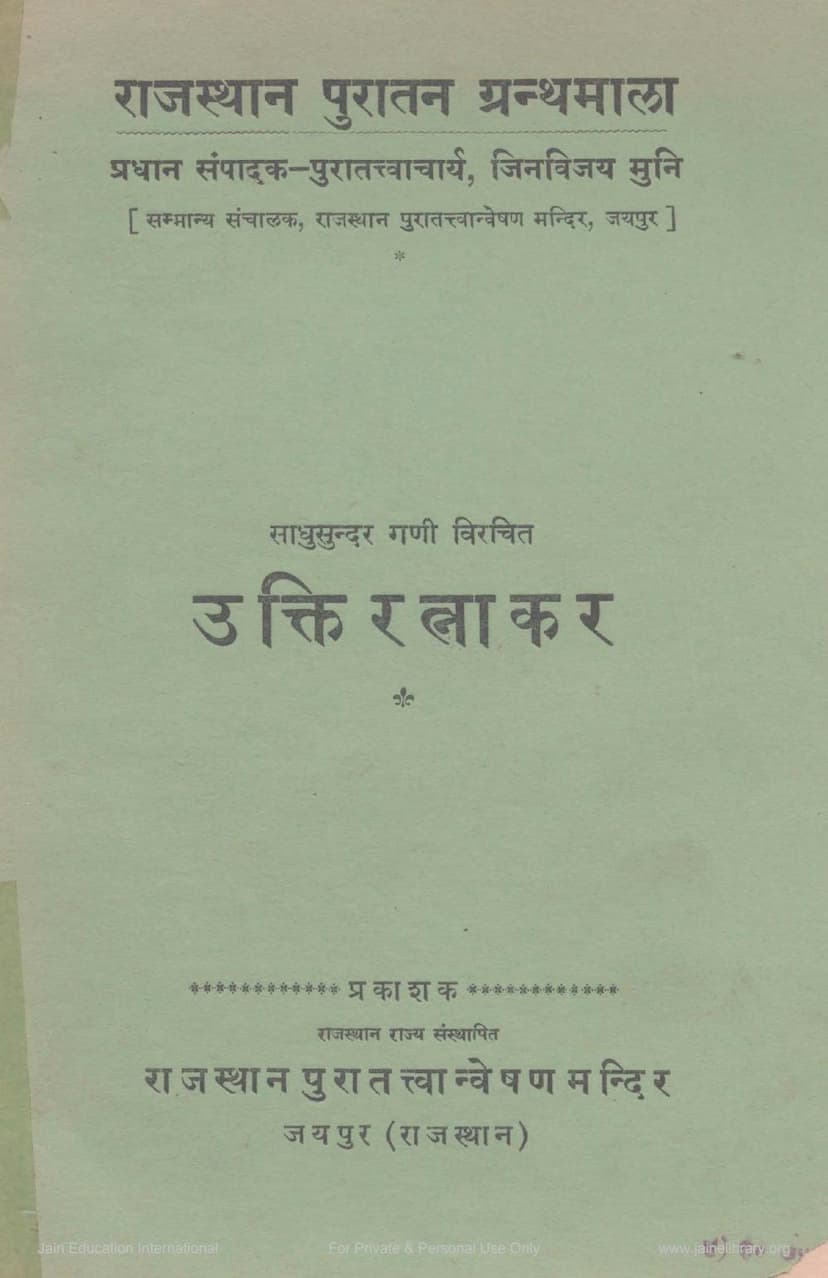Uktiratnakara
Added to library: September 2, 2025

Summary
This document is the preface and introductory material for "Uktiratnakara" (उक्ति रत्नाकर), a Jain text authored by Sadhu Sundar Gani (साधुसुन्दर गणी). Published by the Rajasthan Puratattvanveshan Mandir (राजस्थान पुरातत्त्वान्वेषण मन्दिर) in Jaipur, Rajasthan, under the "Rajasthan Puratan Granthamala" (राजस्थान पुरातन ग्रन्थमाला) series, this work is a significant contribution to the study of ancient Indian languages and literature, particularly concerning the evolution of language and the preservation of cultural heritage.
Here's a breakdown of the key points from the provided text:
1. Publisher and Series:
- The book is published by the Rajasthan Puratattvanveshan Mandir (Rajasthan Oriental Research Institute), Jaipur, Rajasthan.
- It is part of the Rajasthan Puratan Granthamala (राजस्थान पुरातन ग्रन्थमाला) series, indicating a focus on ancient texts from Rajasthan.
- The Pradhan Sampadak (प्रधान संपादक), or Chief Editor, is Munishri Jinvijay (मुनि जिनविजय), who is also the Honorary Director of the Rajasthan Puratattvanveshan Mandir. He is recognized as a distinguished scholar, with an honorary membership in the German Oriental Society and memberships in several other prestigious Indian academic institutions.
2. The Rajasthan Puratattvanveshan Mandir:
- The Mandir, established by the Rajasthan government, is described as a significant institution dedicated to the collection, preservation, research, and publication of ancient literature in Rajasthan.
- Rajasthan's historical significance as a cultural hub is highlighted, noting its reception of various ancient civilizations, religions (Vedic, Jain, Buddhist, Shaiva, Bhagavata, Shakta), and ruling dynasties (Mauryas, Shakas, Guptas, Hunas, Pratiharas, Guhilas, Paramaras, Chalukyas, Chahamanas, Rashtrakutas, etc.).
- This historical context led to a rich literary output in Sanskrit, Prakrit, Apabhramsha, and local dialects (Desya Bhashas).
- The text laments the destruction of much of this literary wealth due to invasions and the migration of manuscripts to other parts of India and abroad.
- It praises the Rajasthan government's initiative in establishing the Mandir to collect and preserve the remaining ancient knowledge.
- The Mandir has already amassed a significant collection of approximately 10,000 ancient manuscripts.
3. The "Uktiratnakara" and the "Auqtik" Literature:
- The primary purpose of the Rajasthan Puratan Granthamala is to bring to light valuable, previously unpublished, or little-known ancient texts.
- "Uktiratnakara" is identified as a work belonging to a genre known as "Auqtik" (औक्तिक) literature.
- Auqtik literature consists of collections of 'aukta' (उक्ता) or 'auqta' (औक्त) words, which are essentially folk or colloquial words (Desya Shabda) with their Sanskrit counterparts. These works served as valuable reference material for understanding the relationship between spoken dialects and classical Sanskrit, especially for those who might not have extensive formal grammatical training.
- The editor mentions a previous publication, "Ukti-Vyakti-Prakaran" (उक्ति-व्यक्ति-प्रकरण), in the Singhi Jain Granthamala, which also deals with this type of linguistic material.
- "Uktiratnakara" was first copied from a manuscript in the Patan Bhandar and later corroborated by a manuscript from the Bikaner Jain Bhandar. Its prevalence suggests it was a popular and useful text.
4. Author: Sadhu Sundar Gani:
- Sadhu Sundar Gani was a Jain monk (Yati) likely residing in Rajasthan.
- His guru was Sadhu Kirti Pathak, a highly learned and respected scholar who reportedly debated with scholars from other faiths in the court of Emperor Akbar, earning him the title "Vadisingh" (वादिसिंह - King of Debates).
- Sadhu Sundar Gani himself authored another significant Sanskrit work, "Dhaturatnakara" (धातुरत्नाकर), a large compendium of Sanskrit verbal roots and their conjugations, completed in VS 1680 (1623 CE).
- He also composed a Sanskrit stuti (praise) in VS 1683 (1626 CE).
- Based on these dates, Sadhu Sundar Gani's active period is placed in the last quarter of the 17th century CE.
- His disciple, Udyakirti, authored a commentary on Vimalkirti's "Padavyavastha" in VS 1681 (1624 CE), highlighting the scholarly lineage.
5. Content and Significance of "Uktiratnakara":
- The work aims to provide the Sanskrit equivalents of Desya (local/colloquial) words prevalent in the author's time and region.
- It begins with a discussion of the Sanskrit Shadkaraka (षट्कारक - the six grammatical cases) to help beginners understand case usage.
- Following this is a substantial glossary of approximately 2400 Desya words and their Sanskrit counterparts.
- The collection also includes other similar ancient texts:
- "Uktiyak" (उक्तीयक): An anonymous work that begins with present tense verb forms, followed by words derived from verb roots (Kridanta), words ending in '-tavya', and then a collection of pronouns etc. It does not include a 'Karaka Vichara' section.
- "Auktika Padani" (औक्तिक पदानि): Another anonymous work that begins with 'Karaka Vichara' (written in local dialect, unlike Sadhu Sundar Gani's Sanskrit treatise). It then covers verb tenses (present, past, future), a word collection, verb conjugations, passive voice usage, case meanings with sentence examples, compound words (Samasa), and causative and desiderative verb forms.
- The editor emphasizes the importance of Sanskrit knowledge for intellectual development and the purity of speech, quoting a saying about the necessity of studying grammar: "Even if you don't study much, study grammar, son. So that you don't become like a dog in calling your own people dogs, and your kingdom a dog's kingdom."
- The linguistic material in these "Auqtik" works is valuable for comparative studies of regional Indian languages (Hindi, Rajasthani, Gujarati, Marathi, Bengali, etc.) and for understanding the development of the national language, Hindi.
6. Index (Anukrama - अनुक्रम): The book is structured as follows:
- Uktiratnakara (उक्ति रत्नाकर) - Pages 1-45
- Uktiyak (उक्तीयक) by an unknown scholar - Pages 46-58
- Auktika Padani (औक्तिक पदानि) by an unknown scholar - Pages 59-82
- Shabdanukrama (शब्दानुक्रम) for Uktiratnakara etc. - Pages 83-118
In essence, "Uktiratnakara" is a linguistic and cultural treasure trove, meticulously compiled and published to preserve and disseminate ancient knowledge about the transformation of language and the rich heritage of Rajasthan.